Rare ice halo display, Sweden
Rare Ice Halo Display in Sweden: A Spectacular Atmospheric Phenomenon
A rare and breathtaking ice halo display took place in Falkoping, Western Sweden on January 16, '21. Captured by Maria Hagberg through still images and video, this mesmerizing spectacle showcased a variety of rare halos that appeared opposite the sun. When witnessing something extraordinary in the sky, it's always worth checking the opposite direction for additional marvels. Let's delve into the highlights of this remarkable event.
A Glorious Display Towards the Sun
The view towards the sun during this ice halo display revealed several noteworthy phenomena. Above the 22° halo and tangent arc, the Parry arcs stood out, creating a striking visual effect. Even more exceptional were the helic arcs that intersected the sun. These captivating displays are formed by hexagonal column crystals suspended horizontally in the air, with a flat prism face aligned parallel to the ground – known as the Parry orientation.
Additionally, an enhanced view of the sundog area unveiled the presence of rare Lowitz arcs. These faint arcs, marked by red dots, added an extra touch of rarity to the already awe-inspiring scene.
Another Glimpse Towards the Sun
Another sunward view during this ice halo display revealed several fascinating features. At the top, the familiar circumzenithal arc made an appearance, formed by horizontal plate crystals. Adjacent to it, curving downwards, was the supralateral arc, created by horizontal column crystals rotating freely about their long axis. This combination of arcs added depth and complexity to the celestial panorama.
Furthermore, a comparative rarity made its presence known – a 46° halo. This particular halo is less commonly observed, making its appearance even more special.
An Enchanting View Away from the Sun
Shifting our gaze to the right and away from the sun, we encountered a captivating sight dominated by the bright parhelic circle. Within this expansive halo, the supralateral and infralateral arcs commanded attention with their vivid colors. The Wegener arc curved outward from its intersection with the tangent arc and 22° halo, adding an intriguing element to the celestial spectacle.
Once again, the Parry-oriented crystals revealed their unique characteristics through the presence of helic and subhelic arcs, accompanied by a horseshoe-shaped Parry supralateral. The combination of these arcs created a visual feast for those fortunate enough to witness this rare ice halo display.
The Blue Spot: A Fascinating Phenomenon
While observing the parhelic circle, a fascinating phenomenon known as the blue spot became apparent. Unlike the uniformly bright segments of the parhelic circle, this particular area suddenly dimmed. The blue spot owes its existence to total internal reflection (TIR) within the ice crystals, where certain angles prevent TIR from occurring. As a result, internally reflected rays dim, leading to the dimming of the parhelic circle in that region.
The wavelength-dependent nature of TIR cutoff contributes to the presence of the blue spot. Red rays diminish first, leaving behind blues and greens, which contribute to the vibrant appearance of the parhelic circle.
Anthelic Arcs: A Rare and Bright Sight
Among the many extraordinary features observed during this ice halo display were the anthelic arcs. These arcs, found in the area opposite the sun, are not frequently seen with such brightness and clarity. The diffuse and Tricker arcs emerged from the parhelic circle, with horizontal columns generating the diffuse arcs and a combination of horizontal and Parry columns contributing to the Tricker arcs. The intricate and convoluted ray paths these arcs traverse through the ice crystals add to their rarity and captivation.
The celestial melange during this event extended further with the presence of antsolar, Wegener, and possibly even Hastings arcs, enhancing the overall grandeur of the atmospheric optics display.
A Closer Look at Diamond Dust
Diamond dust, a naturally occurring phenomenon, played a pivotal role in this exceptional ice halo display. Immersed in it, one could witness the lively dance and swirl of the ice crystals, shimmering and glinting with gem-like colors. Each tiny crystal resembled a perfect ice gemstone, contributing to the almost solid appearance of the halos.
The formation of diamond dust occurs naturally when snow blowers on ski slopes disperse minuscule particles that act as seeds for the growth of snow crystals. While snow crystals themselves do not generate halos, some particles escape and drift several kilometers downwind. As these particles travel, ice crystals with exquisite optical quality gradually form around them, capable of producing equally exquisite halos.
Falkoping, the location near where Maria captured this display, is known for skiing and snow blowers. Although these machines typically operate at night, on that particular day, partly dense and partly thin low stratus clouds were present in many areas. Consequently, natural ice crystals were likely present in the air, possibly supplemented by locally seeded ones from the ski slope.
The growth of these crystals mirrored that of cloud crystals, resulting in a memorable and extraordinary display that showcased nature's artistic prowess.
Humans Creating Halo Displays: Mathematical Insights
While nature's beauty remains unmatched, humans have found ways to simulate halo displays mathematically. In an all-sky view generated by Maria through mathematical calculations, millions of individual sun rays were traced as they refracted and reflected through virtual ice crystals. This method allowed for the discovery of the origins of many halos and contributed to a deeper understanding of these atmospheric phenomena.
However, even with such advancements, the intricate beauty and complexity witnessed in nature's own ice halo displays continue to captivate and inspire awe.
Acknowledgments:
The author extends their gratitude to Andreas Livbom for engaging discussions and valuable insights derived from weather and ski slope research.
Note: This article has been automatically converted from the old site and may not appear as intended.
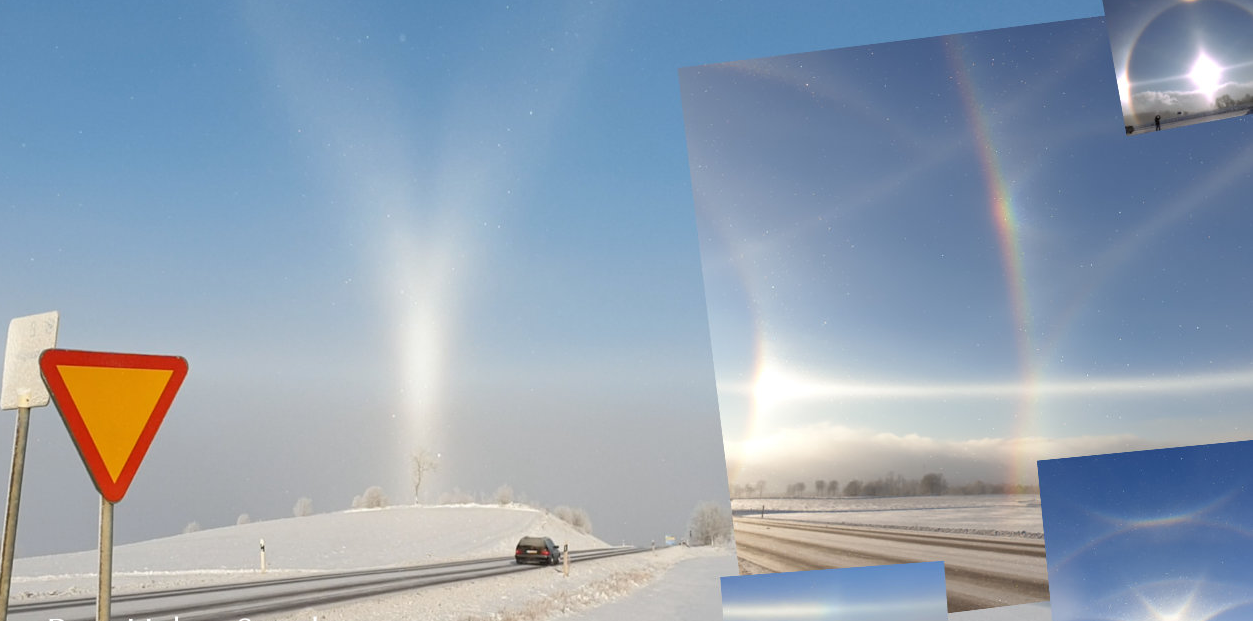
A magnificent diamond dust halo display south of Falkoping in Western Sweden on January 16, '21. Maria Hagberg captured it in still images and video. Maria's images went around the horizon and include views of rare halos opposite the sun. When something spectacular happens in the sky always check the opposite direction. Highlights are below.
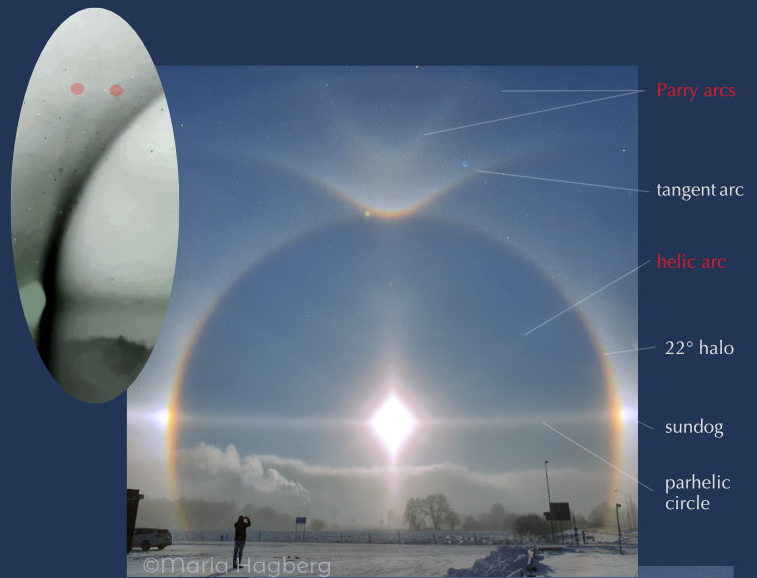
Firstly the view towards the sun.The Parry arcs above the 22° halo and tangent arc are notable.
Even rarer are the helic arcs crossing the sun. Both are produced by hexagonal column crystals drifting horizontal in the air with a flat prism face also aligned horizontally - the Parry orientation.
At left is an enhanced view of the sundog area. The faint arcs marked by red dots are rare Lowitz arcs.

Another sunwards view. At top is the familiar circumzenithal arc from horizontal plate crystals.
Touching it and curving downwards is a suprlateral arc from more horizontal column crystals, this time freely rotating about their long axis.
Blow that is a comparative rarity, a 46° halo

Look to the right and away from the sun. Follow the bright parhelic circle. The highly coloured supralateral and infralateral arcs now dominate the view.
A Wegener arc curves outwards from where it intersected the tangent arc and 22 halo
Parry oriented crystals show themselves again with helic and subhelic arcs plus a horeshoe shaped Parry suparalateral.
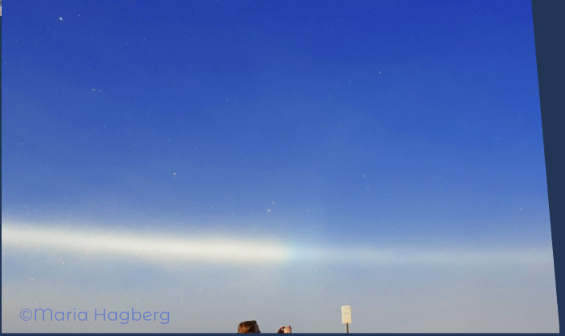
The Blue Spot
The parhelic circle is not uniformly bright. Follow it around from the sun and it suddenly dims.
Many ray paths contribute to the parhelic circle and some involve a total internal reflection (TIR) within the ice crystals.
At certain angles a TIR is not possible and the internally reflected rays dim - the parhelic circle dims.
The blue spot arises because the TIR cut-off is wavelength dependent. Red rays dim first. That leaves blues and greens.
The parhelic circle is not all white!
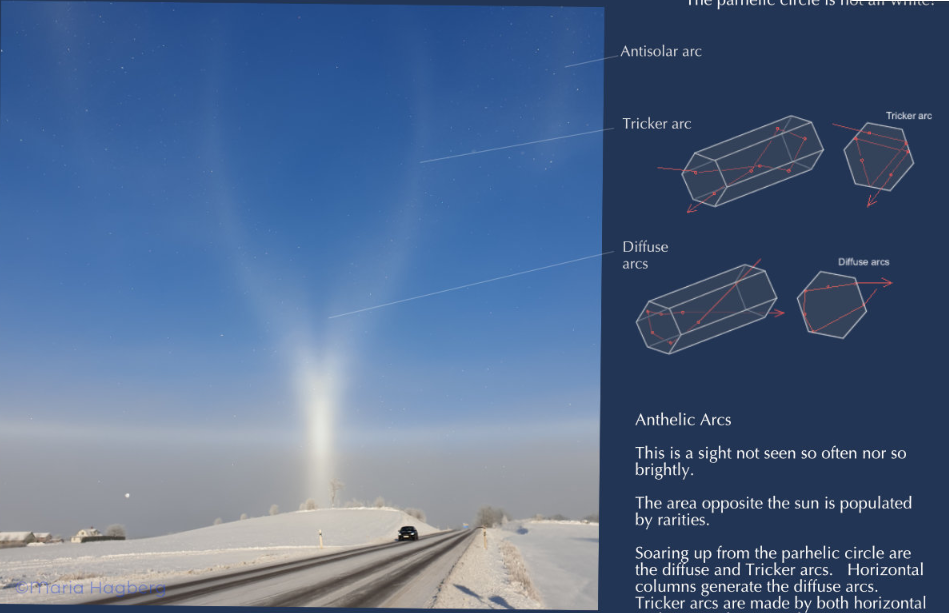
Anthelic Arcs
This is a sight not seen so often nor so brightly.
The area opposite the sun is populated by rarities.
Soaring up from the parhelic circle are the diffuse and Tricker arcs. Horizontal columns generate the diffuse arcs. Tricker arcs are made by both horizontal and Parry columns. Their rarity is understandable when we see their incredibly involved and headachy ray paths through the crystals.
The melange is added to by antsolar, Wegner with maybe even a Hastings arc.

Finally, a closer look at the diamonds dust. Photos do it no justice. Visually, immersed in it, it is alive. Its crystals swirl and dance everywhere. They glint and shine. Gem-like colours. Each tiny crystal its own ice gemstone of great perfection. Halos almost solid.
Diamond dust forms quite naturally. Did Maris's?
Ski-slope snow blowers spray out minuscle particles that act as seeds for the growth of snow crystals. Snow crystals do not make halos. However, some particles escape to drift kilometers downwind. As they so so, ice crystals od exquisite optical quality slowly grow around them. They can generate equally exquisite halos.
Falkoping, near Maris's location, has skiing and snow blowers but they ususally operate only at night. On that day there were partly dense, partly thin low stratus clouds in many areas so there were certainly natural ice crystals in the air, maybe with local addition od ones seeded by the ski slope.
Whatever, apart from their initial seeding the crystals grew naturally like those of clouds. And they made a memorable display.
Us humans can make halo displays in another way. At right is an all sky view of Maria's display generated mathematically.
Several million individual sun rays were calculated as they refracted and reflected through virtual ice crystals.
The origins of many halos were discovered like this.
No match for nature's beauty though!
Many thanks to Andreas Livbom for discussions and his weather/ski slope research.
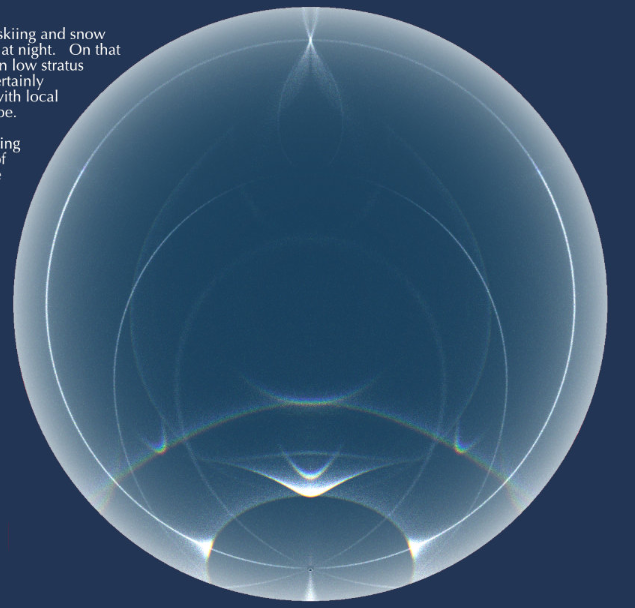
Note: this article has been automatically converted from the old site and may not appear as intended. You can find the original article here.
Reference Atmospheric Optics
If you use any of the definitions, information, or data presented on Atmospheric Optics, please copy the link or reference below to properly credit us as the reference source. Thank you!
-
<a href="https://atoptics.co.uk/blog/rare-ice-halo-display-sweden/">Rare ice halo display, Sweden</a>
-
"Rare ice halo display, Sweden". Atmospheric Optics. Accessed on December 22, 2024. https://atoptics.co.uk/blog/rare-ice-halo-display-sweden/.
-
"Rare ice halo display, Sweden". Atmospheric Optics, https://atoptics.co.uk/blog/rare-ice-halo-display-sweden/. Accessed 22 December, 2024
-
Rare ice halo display, Sweden. Atmospheric Optics. Retrieved from https://atoptics.co.uk/blog/rare-ice-halo-display-sweden/.